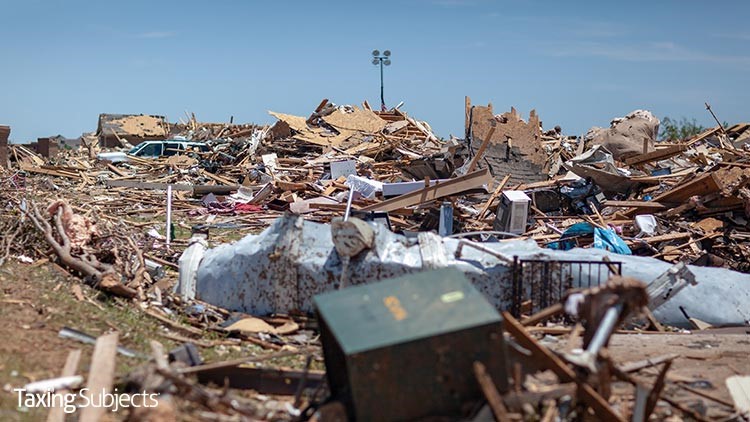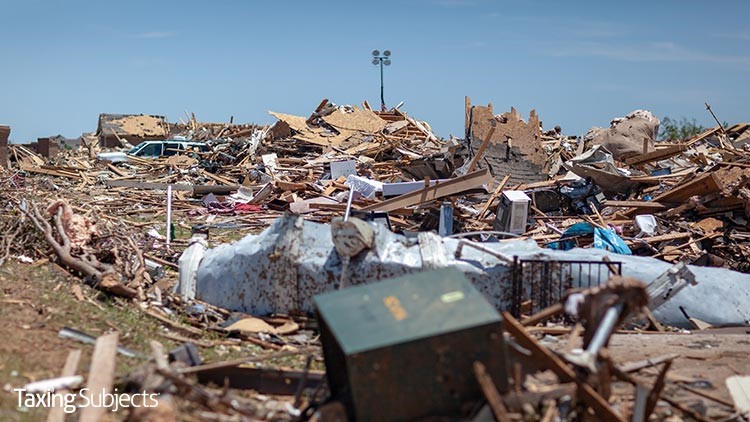
The Internal Revenue Service is giving tornado, thunderstorm and flooding victims in three states extra time to file their various tax returns and make tax payments.
Severe storms raked parts of Mississippi, Tennessee and South Carolina in April; those areas have designated as qualified for individual assistance by the Federal Emergency Management Agency (FEMA). Currently, this includes Clarke, Covington, Grenada, Jasper, Jefferson Davis, Jones, Lawrence, Panola and Walthall counties in Mississippi; Bradley and Hamilton counties in Tennessee; and Aiken, Barnwell, Berkeley, Colleton, Hampton, Marlboro, Oconee, Orangeburg and Pickens counties in South Carolina.
Taxpayers in these counties—and counties added later to the federal disaster declaration—will have until Oct. 15, 2020, to file their individual and business tax returns and to pay any tax due.
Taxpayers in areas added to the federal declaration later will automatically get the same filing and payment relief. The current list of eligible counties and towns is available on the disaster relief page on IRS.gov.
What are the terms of the disaster area tax relief?
The exact extent of the tax relief in this new package is laid out in an IRS release:
“The tax relief postpones various tax filing and payment deadlines that occurred starting on April 12. As a result, affected individuals and businesses will have until Oct. 15, 2020, to file returns and pay any taxes that were originally due during this period. This includes 2019 individual and business returns that, due to COVID-19, were due on July 15. Among other things, this also means that affected taxpayers will have until October 15 to make 2019 IRA contributions” the IRS continues.
The Oct. 15 deadline also applies to estimated tax payments for the first two quarters of 2020 that were due on July 15, and the third-quarter estimated tax payment normally due on September 15. It also includes the quarterly payroll and excise tax returns normally due on April 30 and July 31.
Do you need to apply for disaster area tax relief?
The IRS automatically provides such filing and payment relief to any taxpayer who has an address on file within the disaster area. Taxpayers don’t need to contact the agency to see if they qualify.
If a taxpayer in the disaster area gets a late-filing or late-payment penalty notice from the IRS that has an original or extended filing, payment or deposit due date that falls within the postponement period, relief is only a phone call away. The taxpayer can merely call the phone number in the written notice to have the penalty abated.
Sometimes a taxpayer may live outside the disaster area, but has records needed to meet a deadline inside the stricken area. If the deadline occurs during the postponement period, the IRS will work with the taxpayer to work out a solution. This include workers assisting relief activities and who are affiliated with a recognized government or philanthropic organization.
Individuals and businesses in a federally declared disaster area who suffered uninsured or unreimbursed disaster-related losses can choose to claim them on either the return for the year the loss occurred (in this case, the 2020 return normally filed next year), or the return for the prior year. This means that taxpayers can, if they choose, claim these losses on the 2019 return they are filling out this tax season.
Those taxpayers who qualify for relief but live outside the federally declared disaster area need to call the IRS at 866-562-5227 once normal operations resume. For more information on services currently available from the IRS, visit the IRS Operations and Services page at IRS.gov/coronavirus.
Any taxpayer claiming a loss due to these storms should write the appropriate FEMA declaration number on the return. these numbers are: 4536 for Mississippi; 4541 for Tennessee; and 4542 for South Carolina. For more details, check out Publication 547.
For general information about disaster recovery, visit disasterassistance.gov.

